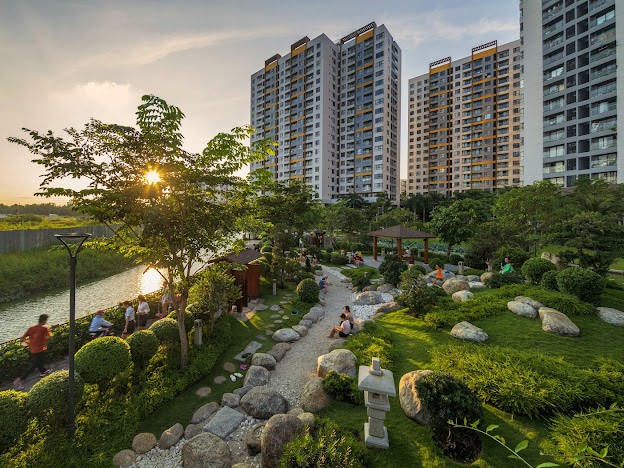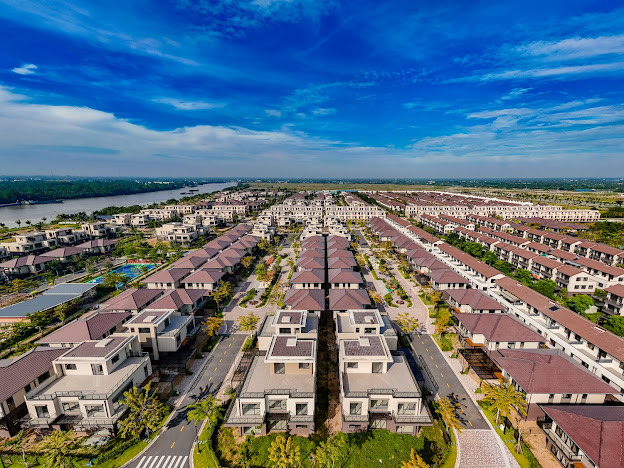Real Estate Market in Vietnam: Positive Signals and Long-Term Growth Drivers
“Positive signals” were the most frequently mentioned phrase in the real estate market reports for the first quarter of 2024, according to market research firms. The first four months of the year have shown several bright spots in the real estate market, bolstering the confidence of investors and real estate businesses.
Cash Flow Returns, Liquidity Improves
According to the Consumer Sentiment Index (CSS) report by Batdongsan.com.vn, the sentiment of real estate buyers and sellers is no longer as cautious as it was in 2023. The real estate market sentiment index for the first half of 2024 increased by 3 points compared to the second half of 2023, due to improved consumer satisfaction with the potential for real estate price increases, home loan interest rates and policies, and market conditions.
Furthermore, Batdongsan.com.vn’s report indicates that consumer interest in searching for real estate has rebounded in the first quarter of 2024, with 62% of survey respondents expressing willingness to seize opportunities to purchase discounted or policy-incentivized real estate.
The warming up of the market is most evident in the significant increase in new supply entering the market and the stabilization of transaction rates. As the real estate market begins to heat up in the early part of the year, real estate brokers, trading floors, and developers have launched early sales campaigns to avoid missing opportunities to reach large numbers of potential customers.
For example, the Hanoi market recently witnessed 5,000 people lining up to book units in a newly opened project. In addition, a number of large developers such as Vingroup, MIKGroup, and Capitaland have begun to launch a series of projects on the market.
In the southern region, following the Tet holiday, a range of products from developers such as Masterise Homes, Nam Long, and Phu Dong from Ho Chi Minh City to Binh Duong, Ba Ria-Vung Tau, and Long An have been launched onto the market, with significantly improved liquidity. According to the real estate market report for Ho Chi Minh City and neighboring provinces conducted by DKRA Group, the first quarter of 2024 saw approximately 12,967 newly supplied primary apartments and approximately 2,000 apartments sold. For the townhouse and villa segment, the primary supply in Ho Chi Minh City and neighboring provinces in the first quarter of 2024 was approximately 4,345 units, with the volume of transactions on this supply increasing by 43%.
In line with this, real estate prices have continued to rise, particularly in the apartment segment. According to batdongsan.com.vn, asking prices for apartments in Hanoi have reached close to those in Ho Chi Minh City, reaching an average of VND 46 million/m2 in early 2024, approaching Ho Chi Minh City’s VND 48 million/m2 mark.

Mizuki Park project amenities. Mr. Lucas Ignatius Loh Jen Yuh – General Director of Nam Long Group believes that the company will increase its competitive advantage for its products by focusing on amenities, services, and the buying experience.
Mr. Lucas Ignatius Loh Jen Yuh, General Director of Nam Long Group, stated that the real estate sector in Vietnam is entering a more “mature” phase, where development is not as rapid but rather requires a high level of due diligence in product research and development from developers to meet the real needs of the market and balance supply and demand. This is similar to the experience of Singapore, the US, China, and other developed countries in the past.
In the future, increasing land funds and housing supply will mark a new phase of competition among real estate developers. Companies will seek to attract homebuyers through product diversification, making aspects such as services, buying experience, and brand awareness increasingly important. For Nam Long Group, instead of competing solely on price, the company aims to differentiate itself through product and service offerings, delivering unique lifestyles tailored to customers in every segment it develops for.
Long-Term Growth Drivers
Positive signals in the first quarter of the year are opening up a new cycle of growth for the real estate market. Experts believe that this is due to the combined positive effects of several factors, including lower interest rates, a more flexible legal framework, and unprecedented stimulus policies from major real estate developers.
Recently, the banking system has continuously lowered deposit interest rates to around 5%/year, and lending rates for home purchases have also decreased to between 5-10.5%/year. This has made it easier for people to access financial leverage.
In addition to attractive lending rates, the legal framework for the real estate market is also becoming more flexible. The resolution of legal obstacles has boosted lending to real estate companies and homebuyers, unlocking capital flows and creating a legal framework for the market to thrive.

Appearance of the Waterpoint project in the West of Ho Chi Minh City, developed by Nam Long Group.
Among the bright spots in the market in the first few months of the year were products that met real housing needs with high construction quality and amenities, catering to the needs of end-users, and with reasonable prices. At the general meeting of shareholders held a few days ago, Mr. Nguyen Xuan Quang – Chairman of the Board of Directors of Nam Long Group stated that the market opportunity for real estate companies is currently quite good. Interest rates for home loans have fallen below pre-Covid-19 levels, and can compete with interest rates in regional countries. He also revealed that Nam Long’s pre-sales in the first quarter reached approximately VND 1,160 billion, five times higher than the same period last year, demonstrating the return of confidence among homebuyers.
Another important factor is the continued attractiveness of the domestic market. Mr. Lucas Ignatius Loh Jen Yuh believes that the Vietnamese economy has significant potential and that the real estate sector is in its early stages of growth. A positive indicator is the pace of urbanization in major cities. This rate is around 38-40%, similar to the level recorded in China in the 2000s.
According to the General Director of Nam Long Group, with the current urbanization rate, the demand for housing, offices, shopping malls, and commercial centers in Vietnam is enormous. In addition, the number of industrial parks as well as critical infrastructure for the logistics sector remains low. The development of infrastructure will lead to the expansion of cities and towns, creating the potential to attract large populations. Therefore, cities such as Hanoi and Ho Chi Minh City still have ample room for growth, which translates into opportunities for the real estate sector.
In this context, Nam Long aims to focus its product portfolio in the 2024-2026 period on affordable housing and commercial real estate products that serve its existing integrated urban ecosystem. Building on this foundation, the company will begin to explore additional residential real estate product lines that are suited to the “mature” market of the future. The company will also seek opportunities in real estate formats












